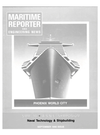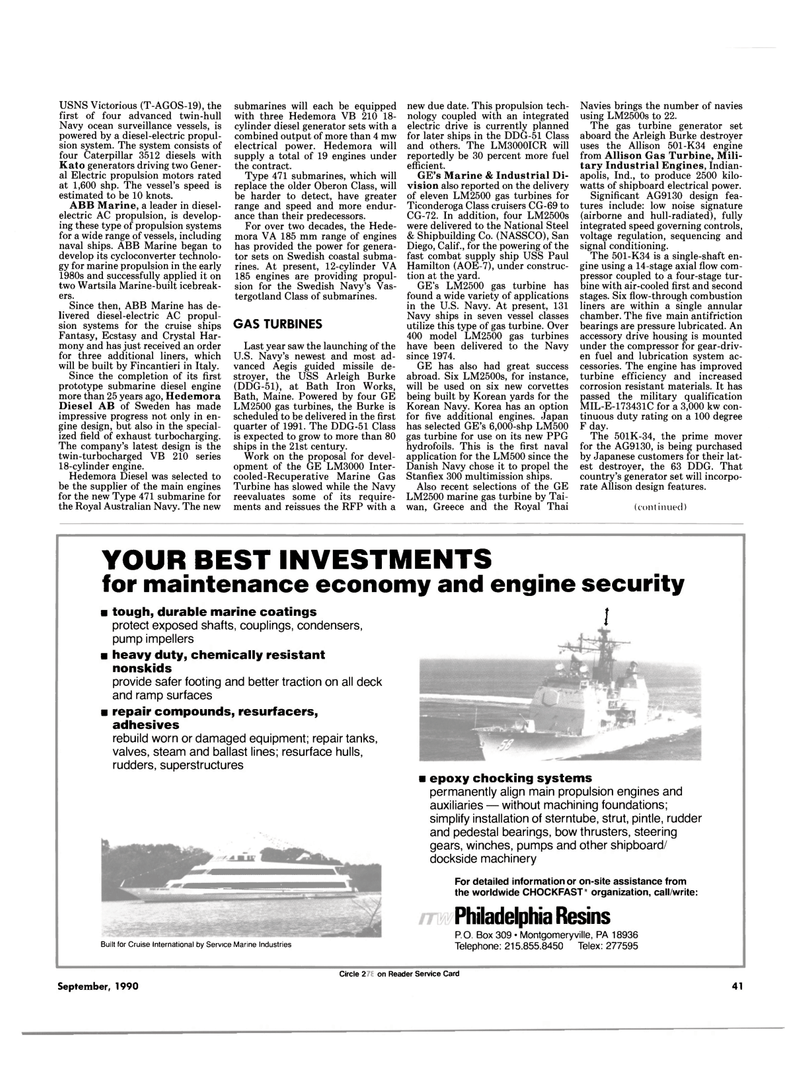
Page 39: of Maritime Reporter Magazine (September 1990)
Read this page in Pdf, Flash or Html5 edition of September 1990 Maritime Reporter Magazine
USNS Victorious (T-AGOS-19), the first of four advanced twin-hull
Navy ocean surveillance vessels, is powered by a diesel-electric propul- sion system. The system consists of four Caterpillar 3512 diesels with
Kato generators driving two Gener- al Electric propulsion motors rated at 1,600 shp. The vessel's speed is estimated to be 10 knots.
ABB Marine, a leader in diesel- electric AC propulsion, is develop- ing these type of propulsion systems for a wide range of vessels, including naval ships. ABB Marine began to develop its cycloconverter technolo- gy for marine propulsion in the early 1980s and successfully applied it on two Wartsila Marine-built icebreak- ers.
Since then, ABB Marine has de- livered diesel-electric AC propul- sion systems for the cruise ships
Fantasy, Ecstasy and Crystal Har- mony and has just received an order for three additional liners, which will be built by Fincantieri in Italy.
Since the completion of its first prototype submarine diesel engine more than 25 years ago, Hedemora
Diesel AB of Sweden has made impressive progress not only in en- gine design, but also in the special- ized field of exhaust turbocharging.
The company's latest design is the twin-turbocharged VB 210 series 18-cylinder engine.
Hedemora Diesel was selected to be the supplier of the main engines for the new Type 471 submarine for the Royal Australian Navy. The new submarines will each be equipped with three Hedemora VB 210 18- cylinder diesel generator sets with a combined output of more than 4 mw electrical power. Hedemora will supply a total of 19 engines under the contract.
Type 471 submarines, which will replace the older Oberon Class, will be harder to detect, have greater range and speed and more endur- ance than their predecessors.
For over two decades, the Hede- mora VA 185 mm range of engines has provided the power for genera- tor sets on Swedish coastal subma- rines. At present, 12-cylinder VA 185 engines are providing propul- sion for the Swedish Navy's Vas- tergotland Class of submarines.
GAS TURBINES
Last year saw the launching of the
U.S. Navy's newest and most ad- vanced Aegis guided missile de- stroyer, the USS Arleigh Burke (DDG-51), at Bath Iron Works,
Bath, Maine. Powered by four GE
LM2500 gas turbines, the Burke is scheduled to be delivered in the first quarter of 1991. The DDG-51 Class is expected to grow to more than 80 ships in the 21st century.
Work on the proposal for devel- opment of the GE LM3000 Inter- cooled-Recuperative Marine Gas
Turbine has slowed while the Navy reevaluates some of its require- ments and reissues the RFP with a new due date. This propulsion tech- nology coupled with an integrated electric drive is currently planned for later ships in the DDG-51 Class and others. The LM3000ICR will reportedly be 30 percent more fuel efficient.
GE's Marine & Industrial Di- vision also reported on the delivery of eleven LM2500 gas turbines for
Ticonderoga Class cruisers CG-69 to
CG-72. In addition, four LM2500s were delivered to the National Steel & Shipbuilding Co. (NASSCO), San
Diego, Calif., for the powering of the fast combat supply ship USS Paul
Hamilton (AOE-7), under construc- tion at the yard.
GE's LM2500 gas turbine has found a wide variety of applications in the U.S. Navy. At present, 131
Navy ships in seven vessel classes utilize this type of gas turbine. Over 400 model LM2500 gas turbines have been delivered to the Navy since 1974.
GE has also had great success abroad. Six LM2500s, for instance, will be used on six new corvettes being built by Korean yards for the
Korean Navy. Korea has an option for five additional engines. Japan has selected GE's 6,000-shp LM500 gas turbine for use on its new PPG hydrofoils. This is the first naval application for the LM500 since the
Danish Navy chose it to propel the
Stanfiex 300 multimission ships.
Also recent selections of the GE
LM2500 marine gas turbine by Tai- wan, Greece and the Royal Thai
Navies brings the number of navies using LM2500s to 22.
The gas turbine generator set aboard the Arleigh Burke destroyer uses the Allison 501-K34 engine from Allison Gas Turbine, Mili- tary Industrial Engines, Indian- apolis, Ind., to produce 2500 kilo- watts of shipboard electrical power.
Significant AG9130 design fea- tures include: low noise signature (airborne and hull-radiated), fully integrated speed governing controls, voltage regulation, sequencing and signal conditioning.
The 501-K34 is a single-shaft en- gine using a 14-stage axial flow com- pressor coupled to a four-stage tur- bine with air-cooled first and second stages. Six flow-through combustion liners are within a single annular chamber. The five main antifriction bearings are pressure lubricated. An accessory drive housing is mounted under the compressor for gear-driv- en fuel and lubrication system ac- cessories. The engine has improved turbine efficiency and increased corrosion resistant materials. It has passed the military qualification
MIL-E-173431C for a 3,000 kw con- tinuous duty rating on a 100 degree
F day.
The 501K-34, the prime mover for the AG9130, is being purchased by Japanese customers for their lat- est destroyer, the 63 DDG. That country's generator set will incorpo- rate Allison design features. (continued)
YOUR BEST INVESTMENTS for maintenance economy and engine security • tough, durable marine coatings protect exposed shafts, couplings, condensers, pump impellers • heavy duty, chemically resistant nonskids provide safer footing and better traction on all deck and ramp surfaces • repair compounds, resurfacers, adhesives rebuild worn or damaged equipment; repair tanks, valves, steam and ballast lines; resurface hulls, rudders, superstructures
Built for Cruise International by Service Marine Industries
I • epoxy chocking systems permanently align main propulsion engines and auxiliaries — without machining foundations; simplify installation of sterntube, strut, pintle, rudder and pedestal bearings, bow thrusters, steering gears, winches, pumps and other shipboard/ dockside machinery
For detailed information or on-site assistance from the worldwide CHOCKFAST" organization, call/write:
Philadelphia Resins
P.O. Box 309 • Montgomeryville, PA 18936
Telephone: 215.855.8450 Telex: 277595
Circle 210 on Reader Service Card
September, 1990 41

 38
38

 40
40
